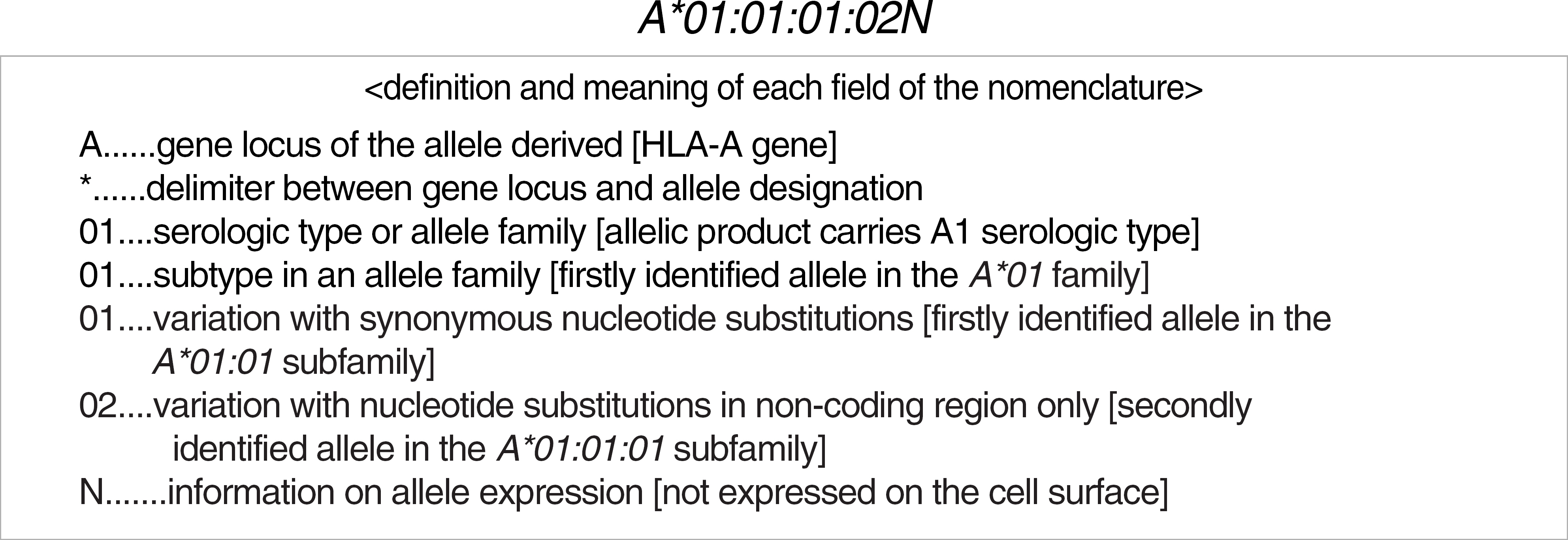Korean J Lab Med.
2010 Jun;30(3):203-217. 10.3343/kjlm.2010.30.3.203.
New HLA Nomenclature (2010) and Its Clinical Application in Koreans
- Affiliations
-
- 1Hallym Institution for Genome Application, Hallym University College of Medicine, Anyang, Korea. leekw@hallym.or.kr
- 2Department of Laboratory Medicine, Seoul National University College of Medicine, Seoul, Korea.
- KMID: 1781617
- DOI: http://doi.org/10.3343/kjlm.2010.30.3.203
Abstract
- Human leukocyte antigen (HLA) gene region encodes a set of HLA molecules functioning critical roles in immune response. Each HLA gene locus shows extensive polymorphism with ever-increasing number of alleles. The HLA nomenclature system for alleles defined by DNA typing was first established in 1987 and has been revised several times. Recently, it has been revised again with a new frame that can accommodate ever-increasing number of new alleles. The new system has also introduced the novel suffixes, P and G, to simplify reporting of ambiguous strings of alleles in typing reports. This review introduces the HLA nomenclature system-2010 in conjunction with its clinical application in Koreans.
Keyword
MeSH Terms
Figure
Cited by 2 articles
-
Absence of
HLA-B*1502 andHLA-A*3101 Alleles in 9 Korean Patients With Antiepileptic Drug-Induced Skin Rash: A Preliminary Study
Ju Sun Song, Eun-Suk Kang, Eun Yeon Joo, Seung Bong Hong, Dae-Won Seo, Soo-Youn Lee
Ann Lab Med. 2014;34(5):372-375. doi: 10.3343/alm.2014.34.5.372.Allelic and Haplotypic Diversity of HLA-A, -B, -C, and -DRB1 Genes in Koreans Defined by High-resolution DNA Typing
Hye Yoon Chung, Jung Ah Yoon, Bok Youn Han, Eun Yung Song, Myoung Hee Park
Korean J Lab Med. 2010;30(6):685-696. doi: 10.3343/kjlm.2010.30.6.685.
Reference
-
1.Massey HD., McPherson RA. The major histocompatibility complex of man. McPherson RA, Pincus MR, editors. Henry's clinical diagnosis and management by laboratory methods. 21st ed.China: Saunders Elsevier;2007. p. 876–93.2.Thorsby E. A short history of HLA. Tissue Antigens. 2009. 74:101–16.
Article3.WHO Nomenclature Committee. Nomenclature for factors of the HL-a system. Bull World Health Organ. 1968. 39:483–6.4.Terasaki PI., McClelland JD. Microdroplet assay of human serum cytotoxins. Nature. 1964. 204:998–1000.
Article5.Marsh SG., Albert ED., Bodmer WF., Bontrop RE., Dupont B., Erlich HA, et al. Nomenclature for factors of the HLA system, 2010. Tissue Antigens. 2010. 75:291–455.6.Bodmer WF., Albert E., Bodmer JG., Dupont B., Mach B., Mayr WR, et al. Nomenclature for factors of the HLA system, 1987. Dupont B, editor. Immunobiology of HLA. New York: Springer-Verlag;1989. p. 72–9.
Article7.Robinson J., Malik A., Parham P., Bodmer JG., Marsh SG. IMGT/HLA database—a sequence database for the human major histocompatibility complex. Tissue Antigens. 2000. 55:280–7.
Article8.Lee KW., Yang SY. HLA-B22 diversity including a novel B54 variant (B∗5507) in the Korean population. Hum Immunol. 1999. 60:731–7.
Article9.Bodmer JG., Marsh SG., Albert ED., Bodmer WF., Bontrop RE., Charron D, et al. Nomenclature for factors of the HLA system, 1996. Tissue Antigens. 1997. 49:297–321.
Article10.Elsner HA., Blasczyk R. Immunogenetics of HLA null alleles: implications for blood stem cell transplantation. Tissue Antigens. 2004. 64:687–95.
Article11.Cano P., Klitz W., Mack SJ., Maiers M., Marsh SG., Noreen H, et al. Common and well-documented HLA alleles: report of the Ad-Hoc committee of the American society for histocompatiblity and immunogenetics. Hum Immunol. 2007. 68:392–417.12.Lee KW., Oh DH., Lee C., Yang SY. Allelic and haplotypic diversity of HLA-A, -B, -C, -DRB1, and -DQB1 genes in the Korean population. Tissue Antigens. 2005. 65:437–47.
Article13.Yi DY., Lee W., Huh JY., Hong SG., Jung B., Baek JY, et al. HLA allele frequencies and haplotypic associations of 4,108 cord blood units in Korean by high-resolution sequence-based typing. Korean J Lab Med. 2009. (S2):S425. (이대영, 이우근, 허지영, 홍성근, 정보찬, 백진영등.한국인 제대혈 4,108 단위에서 고해상도 염기서열분석법에 의한HLA대립유전자와일배체형빈도.대한진단검사의학회지2009(부록2):S425.).14.Song EY., Park H., Roh EY., Park MH. HLA-DRB1 and -DRB3 allele frequencies and haplotypic associations in Koreans. Hum Immunol. 2004. 65:270–6.
Article15.Lee KW., Jung YA. Additional sequence analysis outside exon 2 clarifies DRB1∗12 and DRB1∗14 allelic frequencies in Koreans. Hum Immunol. 2009. 70:464–7.
Article16.Marsh SG., Albert ED., Bodmer WF., Bontrop RE., Dupont B., Erlich HA, et al. Nomenclature for factors of the HLA system, 2004. Tissue Antigens. 2005. 65:301–69.
Article17.Marsh SG., Albert ED., Bodmer WF., Bontrop RE., Dupont B., Erlich HA, et al. Nomenclature for factors of the HLA system, 2002. Tissue Antigens. 2002. 60:407–64.



